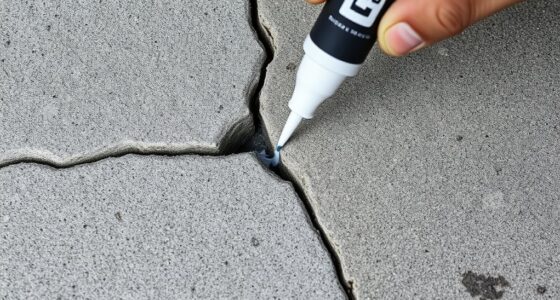Roofs generally need reshingling every 15 to 30 years, but this depends on the material you chose and how well you maintain it. Regular inspections every six months are crucial, especially for roofs older than 10 years. Look out for missing, cracked, or curling shingles and address any water stains early to avoid costly damage. Simple maintenance, like cleaning gutters and trimming overhanging branches, can extend your roof's lifespan. Staying proactive can save you money in the long run. Find out how to keep your roof in top shape and avoid the hassle of unexpected repairs.
Key Takeaways
- Roofs typically need reshingling every 15-30 years for asphalt shingles and 40-70 years for metal roofs, depending on material and maintenance.
- Regular inspections every six months can help identify wear early, potentially extending the lifespan of your roof.
- Key signs of deterioration include missing or cracked shingles, water stains, and sagging roof decks, indicating the need for reshingling.
- Proper maintenance practices, like cleaning gutters and trimming branches, can significantly delay the need for reshingling.
- Timely reshingling prevents further damage, enhances energy efficiency, and maintains property value while ensuring compliance with building codes.
Factors Influencing Reshingling Frequency
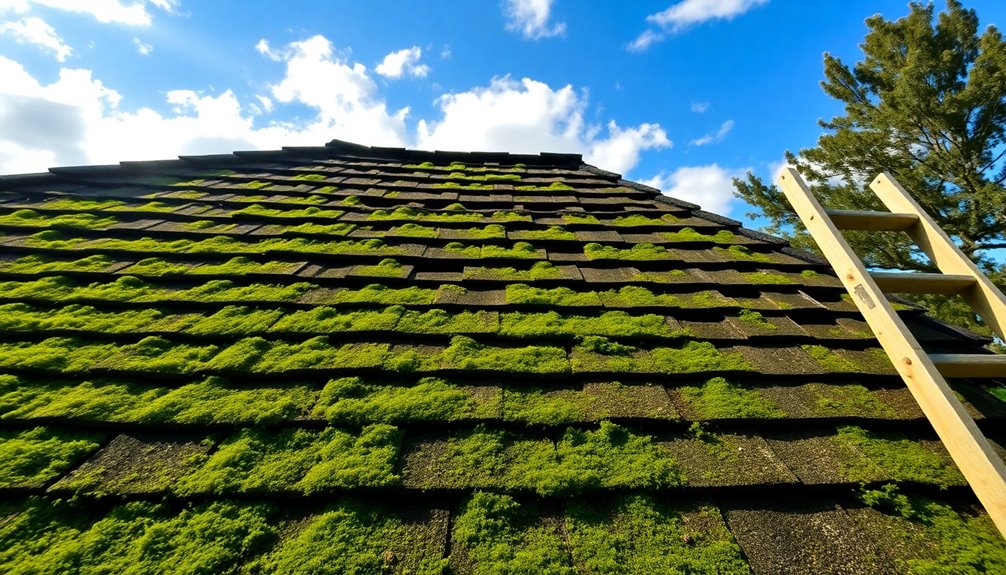
When considering how often you might need to reshinge your roof, several key factors come into play. The type of roofing materials significantly affects the frequency of roof maintenance; for instance, asphalt shingles generally last 15-30 years, depending on quality and care.
If your roof is well-maintained, you may delay reshingling. Regular inspections are crucial, as they help you spot signs of wear like curling or missing shingles early on.
Homes in areas with severe weather conditions may experience faster degradation, necessitating more frequent checks. A thorough inspection every six months can safeguard against unexpected issues, ensuring your shingles last as long as possible.
Prioritizing maintenance can extend their lifespan, reducing the need for reshingling sooner than necessary.
Signs Your Roof Needs Reshingling
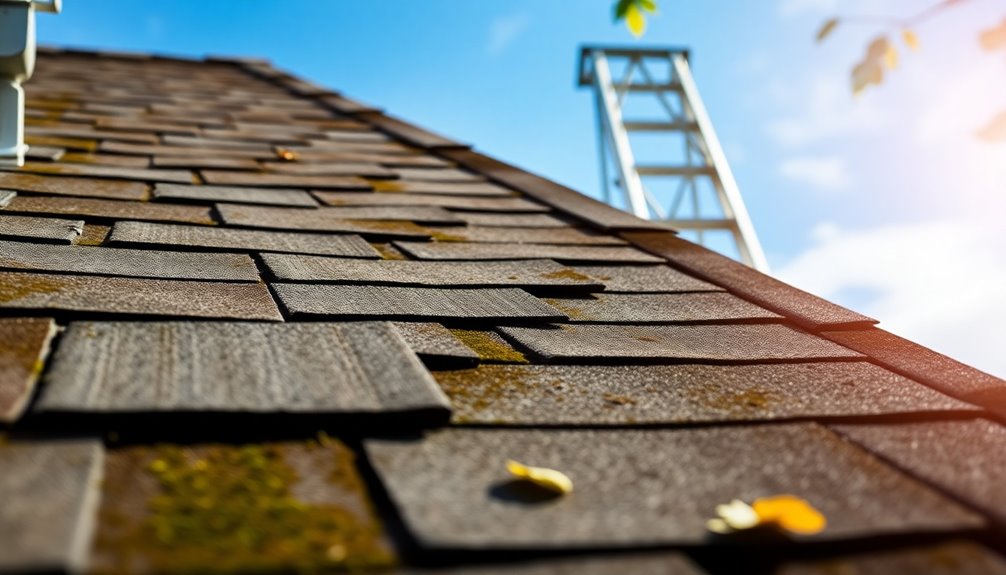
If you notice missing, cracked, or curling shingles on your roof, it's a clear sign that reshingling may be necessary. These missing or damaged shingles can expose your roof to leaks and further damage.
Look out for water stains on your ceilings or walls, as they indicate underlying issues that could lead to mold growth. A sagging roof deck is another serious warning, often needing immediate reshingling to restore structural integrity.
Additionally, excessive granule loss from asphalt shingles can be a sign of aging roofs, especially if you see granules in your gutters.
Regular roof inspections are crucial, particularly for roofs over 20 years old, to catch these signs of water damage early and prevent costly repairs.
Recommended Reshingling Schedule

Regular inspections of your roof not only help identify signs of wear but also set the stage for a recommended reshingling schedule.
For asphalt shingle roofs, which have an average lifespan of about 20 years, plan for potential reshingling around that timeframe. If your roof is over 10 years old, conducting biannual roof inspections is crucial.
During these inspections, look for curled, cracked, or missing shingles, as these are clear indicators that reshingling may be needed. In storm-prone areas, increase the frequency of inspections to catch damage early.
Following these maintenance tips will help extend your roof's lifespan and delay the need for full reshingling, ensuring your home stays protected.
Importance of Regular Inspections
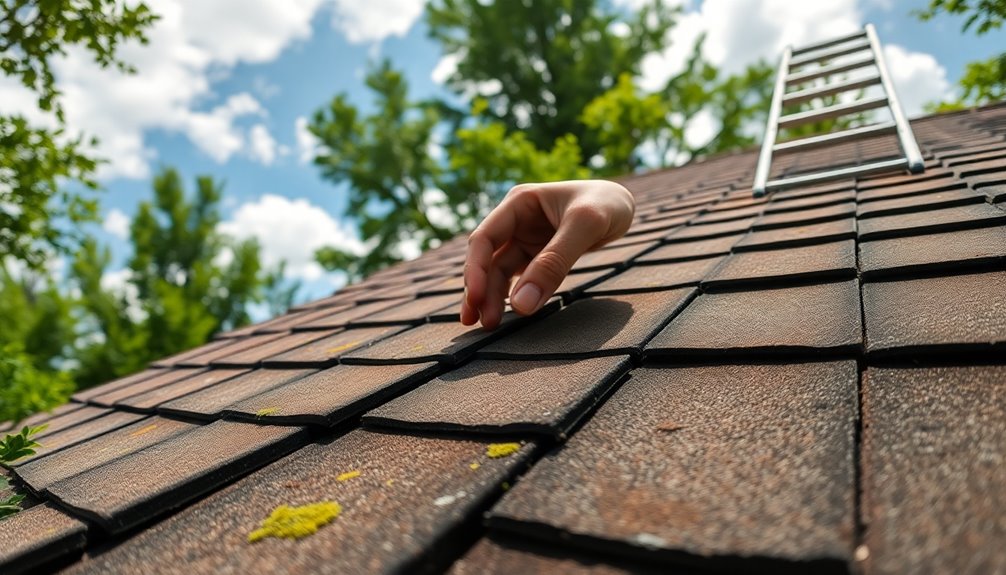
While many homeowners overlook roof inspections, they play a crucial role in maintaining your home's integrity.
Regular inspections by a professional roofer help identify signs of wear, such as missing shingles and roof leaks, before they escalate into costly issues. These check-ups, which typically last between 45 minutes to 2 hours, are essential for effective roof maintenance.
Neglecting them can lead to significant water damage and even mold growth, jeopardizing both your roof's performance and your home's health.
By incorporating regular inspections into your maintenance programs, you can extend your roof's lifespan, potentially lasting 25 years or more.
Plus, keeping documentation of inspections and repairs helps retain your manufacturer warranties, ensuring you stay covered.
Common Roofing Materials and Lifespans

When considering a new roof, understanding the different materials available and their lifespans can help you make an informed decision.
Common roofing materials include asphalt shingles, which can last 15 to 30 years, and wood roofs like cedar shakes, lasting 20 to 25 years with proper maintenance.
Metal roofs offer remarkable durability, ranging from 40 to 70 years, while tile roofs, particularly clay and concrete, can exceed 50 years when well cared for.
Regular inspections and maintenance play a crucial role in extending the lifespans of these roofing materials.
Maintenance Tips to Extend Lifespan
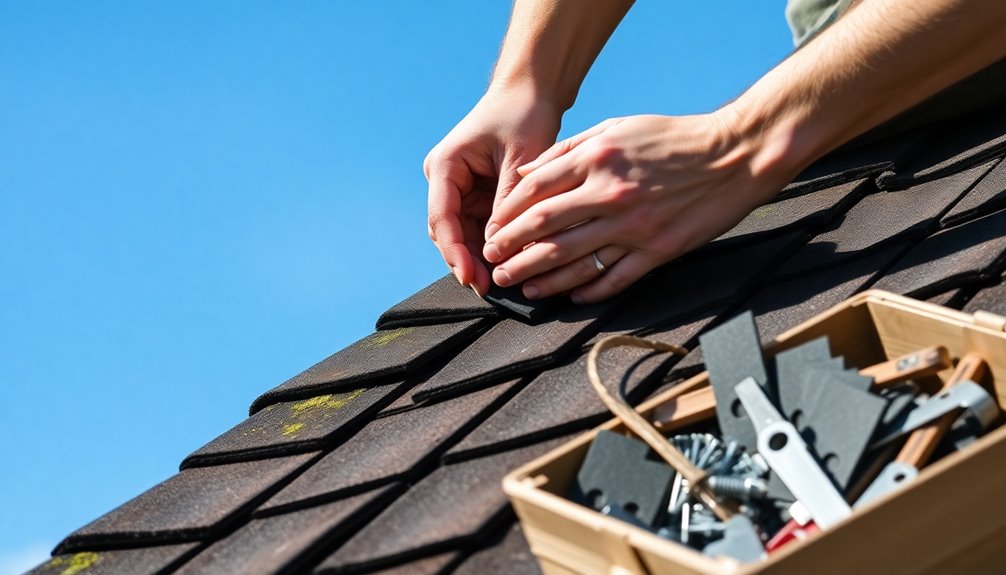
To keep your roof in top shape and extend its lifespan, it's essential to stay proactive about maintenance. Schedule regular inspections every six months to catch signs of wear, like damaged shingles.
Cleaning the roof every 1-2 years helps remove debris and prevents moisture retention, which can lead to water damage. Ensure your attic has proper ventilation to reduce heat and moisture buildup, significantly prolonging your roof's lifespan.
Don't forget to maintain your gutters and downspouts by cleaning them at least twice a year to prevent water backup. Lastly, promptly address minor roof repair needs to prevent extensive damage.
Following these maintenance tips will help you protect your investment and ensure a longer-lasting roof.
Cost Considerations for Reshingling
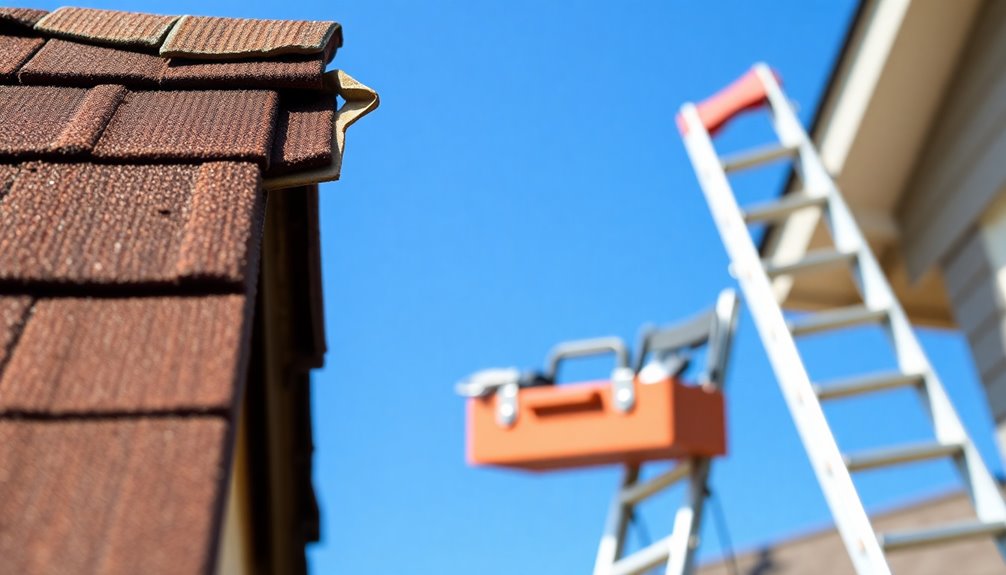
Understanding the costs associated with reshingling your roof is crucial for effective budgeting. The average cost for this roofing project ranges from $5,000 to $10,000, depending on size and complexity.
Asphalt shingles last about 20 years, so you'll need to consider potential roof replacement costs as they approach their lifespan. Regular annual roof maintenance, which can cost between $120 and $400, helps extend the life of your roof and may delay costly repairs.
Additionally, reshingling costs might increase if you need to upgrade underlayment or ventilation systems. While high-quality shingles may seem pricey up front, their longevity and warranties often provide better long-term value, making them a smart investment for your home’s future. It’s also important to consider that investing in 50year shingles top brands can significantly enhance the overall durability of your roof. These premium shingles not only withstand harsh weather conditions but also come with extended warranties that offer peace of mind for homeowners. Ultimately, the benefits of selecting high-quality materials far outweigh the initial costs, ensuring that your roof remains a reliable shield for your property for decades to come.
Professional vs. DIY Reshingling
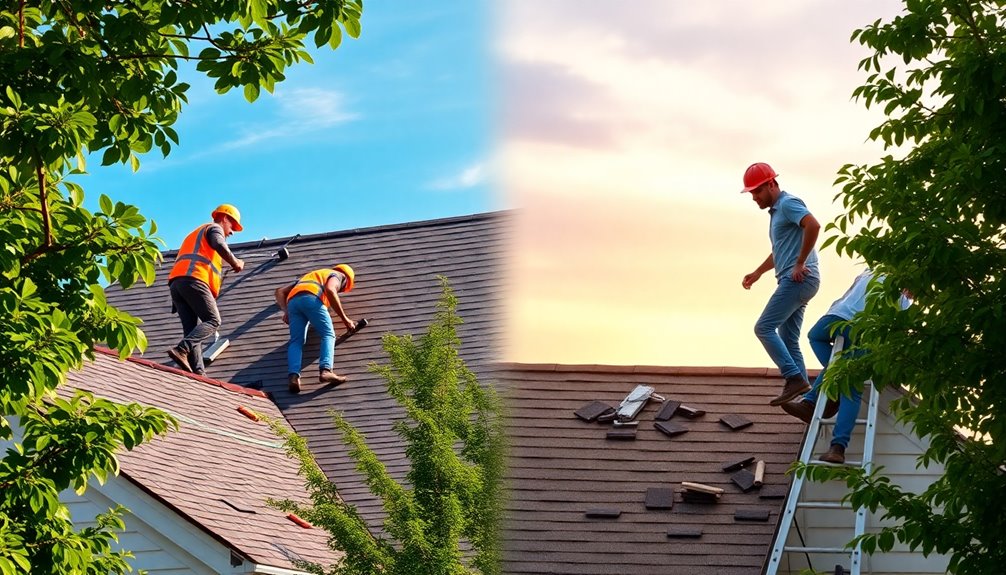
Deciding between professional and DIY reshingling can significantly impact both your budget and the longevity of your roof.
Hiring a roofing contractor ensures expert installation, adhering to building codes and manufacturer specifications, which can save you from costly replacement costs down the line. They also provide warranties on workmanship, giving you peace of mind.
On the other hand, DIY reshingling might seem cost-effective, but it requires a solid understanding of roofing materials and techniques. Mistakes can lead to leaks or premature failure.
Additionally, consider the safety hazards involved; without proper training and gear, working at heights can be dangerous.
If your roof is over 20 years old, professional assessments and roof inspections are highly recommended.
Seasonal Maintenance Best Practices
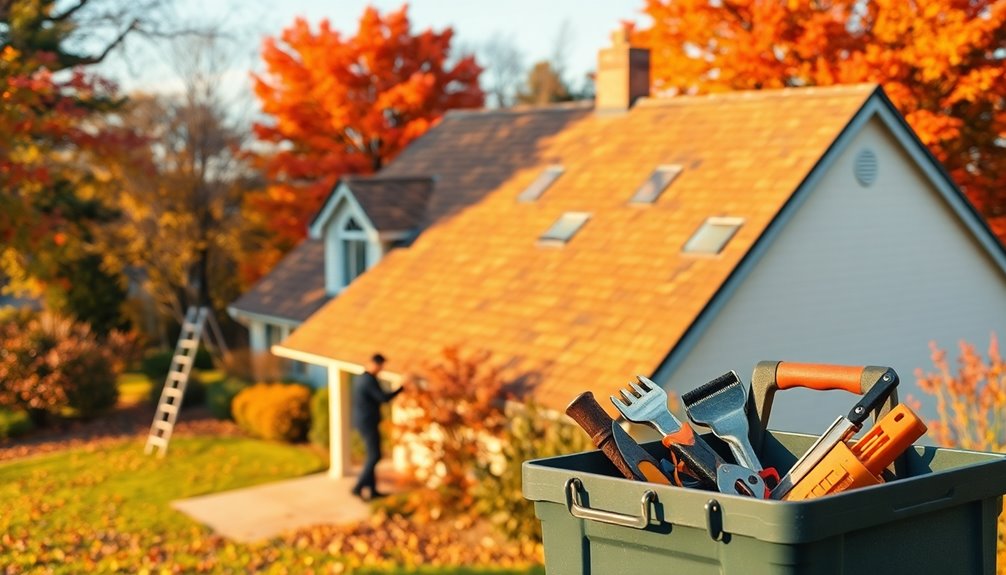
After weighing the pros and cons of professional versus DIY reshingling, it's vital to focus on maintaining your roof throughout the year.
Conduct regular inspections in spring and fall to identify missing or damaged shingles and check for clogged gutters. Keeping gutters clean helps prevent water damage, which can shorten your roof's lifespan.
After severe weather, inspect for dents or displaced flashing to prevent leaks. Trim overhanging branches to minimize debris buildup that can harm shingles.
Additionally, ensure roof vents and flashing are clear of blockage to maintain proper ventilation.
Resources for Roof Maintenance
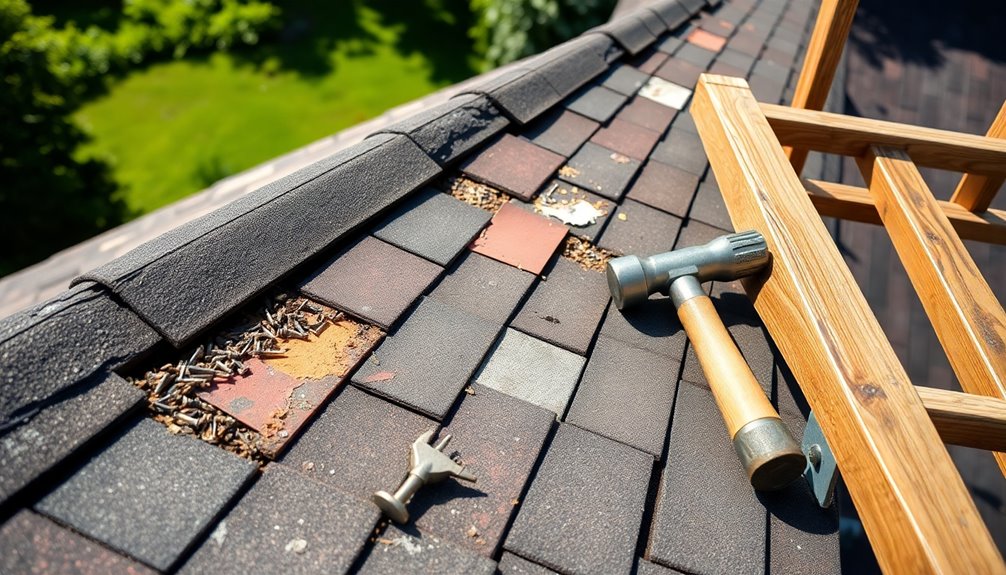
When it comes to roof maintenance, having the right resources at your fingertips can make all the difference in keeping your roof in top shape.
Start by maintaining a log of your inspections and repairs; this helps you track your roof's condition and know when reshingling might be necessary. Many roofing companies offer maintenance programs that include regular inspections, which can extend the roof lifespan and even lead to discounted roof repairs.
Don't underestimate the value of educational resources, such as guides on roof maintenance, to enhance your knowledge.
Finally, schedule professional inspections every few years. These trained experts can identify hidden problems that regular inspections might miss, ensuring your roofing materials remain in optimal condition.
Frequently Asked Questions
What Maintenance Does a Shingle Roof Need?
Your shingle roof needs regular maintenance to stay in good shape. Inspect it annually for missing or damaged shingles, and clean gutters to ensure proper drainage.
Check for moss and algae twice a year, treating them as needed. Maintain attic ventilation to prevent heat and moisture buildup.
If you spot any damaged shingles, replace them promptly to avoid leaks and protect your home. With these steps, you'll extend your roof's lifespan.
What Is Routine Maintenance on a Roof?
Did you know that regular roof maintenance can extend its lifespan by up to 25 years?
To keep your roof in top shape, schedule annual inspections to catch missing shingles or leaks early. Clean your gutters twice a year to prevent water damage, and remove debris to avoid moisture trapping.
Don't forget to check the flashing around chimneys and ensure proper attic ventilation to boost energy efficiency and longevity.
What Is Yearly Maintenance on a Roof?
Yearly maintenance on your roof is crucial for its longevity and performance.
You should inspect for missing or damaged shingles, check the integrity of sealants and flashing, and look for potential leaks.
Don't forget to clean your gutters and remove debris from the roof surface to prevent moisture buildup.
Also, inspect any roof penetrations like chimneys and vents.
Documenting all these activities helps you track your roof's condition and plan future maintenance effectively.
How Often Does a Roof Need to Be Maintained?
Imagine you just bought a cozy house with a ten-year-old roof. You'd want to keep it in good shape, right?
You should maintain your roof at least once a year, inspecting it for wear and tear. If it's older, like your new roof, aim for biannual checks.
After storms, take a closer look for any damage. Consistent upkeep prevents costly repairs and keeps your home safe and sound for years to come.
Conclusion
In the grand tapestry of homeownership, your roof is the protective cloak that shields you from the elements. By staying vigilant and recognizing the signs of wear, you can ensure it remains sturdy and reliable. Remember, a little maintenance now can save you from a storm of trouble later. So, embrace the rhythm of regular inspections and timely reshingling, and your roof will continue to stand tall like a steadfast guardian over your home.





